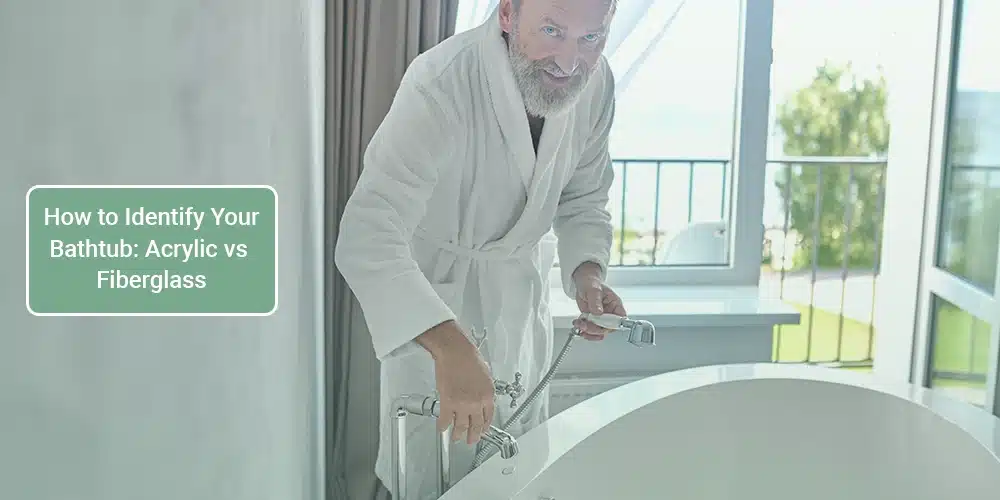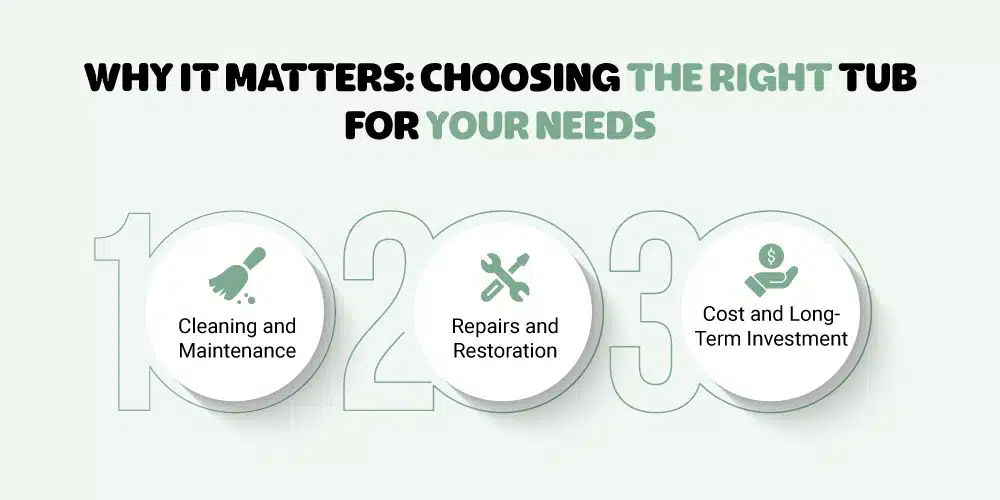Ever thought about what your bathtub is actually made of? Probably not—until you notice scratches, fading, or it doesn’t hold heat the way you’d like. The difference between acrylic and fiberglass isn’t just about looks; it affects everything from comfort to maintenance and how long your tub will last.Studies show that acrylic bathtubs retain heat up to 30% longer than fiberglass ones, making them a better choice for long, warm soaks (Source: Home Improvement Research Institute). Some tubs stay warm and glossy for years, while others wear down faster. So, how do you tell the difference? Let’s break it down in a way that’s easy to spot.
Understanding Acrylic & Fiberglass Bathtubs
What is an Acrylic Bathtub?
Acrylic bathtubs are made from vacuum-formed sheets of acrylic reinforced with fiberglass layers, creating a durable, lightweight, and non-porous surface. According to a study by the National Kitchen & Bath Association (NKBA), acrylic is one of the most preferred bathtub materials due to its heat retention, resistance to chipping, and ease of maintenance (Source: NKBA). Unlike fiberglass, acrylic tubs maintain their glossy finish for years, making them a long-lasting and stylish choice for modern bathrooms.
Why Choose an Acrylic Bathtub?
- Better Heat Retention – Keeps water warm for longer, ideal for soaking.
- Durable & Crack-Resistant – More resistant to wear and tear than fiberglass.
- Easy to Clean – Non-porous surface resists stains and mold buildup.
- Comfortable & Smooth Feel – Provides a sleek, glossy finish that stays intact over time.
- Available in Multiple Designs – Wide range of shapes, sizes, and colors to fit any bathroom aesthetic.
What is a Fiberglass Bathtub?
Fiberglass bathtubs, also known as Fiberglass-Reinforced Plastic (FRP) tubs, are made by layering fiberglass strands with a polyester resin and finishing with a protective gel coat. According to research published by The American Composites Manufacturers Association (ACMA), fiberglass is a cost-effective and lightweight material, making it a popular choice for budget-friendly bathrooms (Source: ACMA). However, fiberglass tubs tend to be less durable than acrylic, as they are more prone to chipping, cracking, and color fading over time.
Why Choose a Fiberglass Bathtub?
- Affordable Option – Cheaper than acrylic, ideal for budget-conscious homeowners.
- Lightweight Construction – Easier to install, especially in upper-floor bathrooms.
- Quick Manufacturing Process – Mass-produced, making them readily available.
- Easy to Repair – Minor cracks and chips can be patched with fiberglass repair kits.
- Variety of Shapes & Sizes – Available in multiple styles for different bathroom layouts.
Physical Characteristics of Acrylic vs. Fiberglass
Understanding the physical properties of acrylic and fiberglass bathtubs can help you distinguish between them at a glance. Whether you’re planning a bathroom renovation or simply curious, let’s break it down:
Acrylic Bathtubs: Sturdy & Luxurious Feel
Acrylic bathtubs are built with vacuum-formed acrylic sheets reinforced with fiberglass, making them heavier and more robust. When you knock on the surface, it gives a solid, deep sound, unlike the hollow feel of fiberglass.Their high-gloss, non-porous finish gives them a sleek, luxurious look that resists fading and discoloration over time. Because acrylic is a better insulator, it retains heat longer—ideal for those who love soaking in warm baths without constantly refilling hot water.
While acrylic is scratch-resistant, it’s not entirely immune to damage. However, minor scratches can be easily buffed out, extending its lifespan.
Fiberglass Bathtubs: Lightweight & Budget-Friendly
Fiberglass bathtubs, made from molded fiberglass and coated with a gel finish, are significantly lighter than acrylic ones. This makes them easier to install but also means they are less durable. When tapped, fiberglass produces a hollow, higher-pitched sound, indicating its thinner construction.Over time, fiberglass tends to fade, chip, and develop visible wear, especially in high-use areas. It’s also more porous, which can lead to staining and water absorption, making it harder to clean compared to acrylic. Heat retention is another drawback—fiberglass cools down quickly, meaning you might need to add warm water more frequently during a bath.
Key TakeawayIf you prefer longevity, heat retention, and a premium feel, acrylic is the better option. If budget, ease of installation, and a lightweight design matter more, fiberglass is a practical choice. |
Testing Methods to Identify Your Bathtub Material
Not sure whether your bathtub is acrylic or fiberglass? Here are some simple yet effective tests to help you determine its material.
The Tap Test: Listen to the Difference
- Lightly knock on the tub’s surface using your knuckles.
- If it produces a deep, solid sound, your tub is likely acrylic—it’s thicker and denser.
- A hollow, higher-pitched sound suggests fiberglass, as it’s thinner and less sturdy.
Why it works: Acrylic bathtubs have multiple reinforced layers, while fiberglass tubs are lighter with a single gel coat, making them sound different when tapped.
Look for Signs of Wear and Tear
- Acrylic tubs are scratch-resistant and rarely chip. If they do get scratched, they can be buffed out.
- Fiberglass tubs tend to crack, chip, and discolor over time, especially in high-use areas.
- Check if the tub surface looks dull and worn out—this is a common sign of fiberglass degradation.
Why it matters: Fiberglass is more porous, leading to gradual wear, while acrylic retains its glossy finish longer.
Check the Edges and Underside
- Remove the overflow cover or an access panel if possible.
- Acrylic tubs have a smooth, reinforced backing, indicating the presence of multiple material layers.
- Fiberglass tubs reveal rough, exposed fibers on the backside, as they are made with fiberglass strands coated with a thin gel layer.
Pro tip: If you can see thread-like fibers or a slightly rough texture underneath, it’s fiberglass.
The Shine and Flex Test
- Acrylic bathtubs have a deep, glossy shine and slightly flex when pressed on the sides.
- Fiberglass tubs appear duller and feel rigid, with little to no flexibility.
Extra tip: If you push on the side of the tub and feel slight movement, it’s likely acrylic. Fiberglass is more brittle and doesn’t flex as easily.
Durability and Maintenance Differences
Feature | Acrylic | Fiberglass |
Durability | More resistant to cracks | Prone to chipping and cracking |
Weight | Heavier | Lighter |
Heat Retention | Retains heat longer | Cools down quickly |
Cost | More expensive | More affordable |
Repairability | Easier to buff out scratches | Harder to repair |
Lifespan | 10-15 years | 5-10 years |
Read More: How long does a bathroom remodel take
Why It Matters: Choosing the Right Tub for Your Needs
Understanding whether your bathtub is acrylic or fiberglass isn’t just about curiosity—it affects how you clean, maintain, and even repair it over time. Here’s why it’s important:
- Cleaning and Maintenance: Keeping Your Tub in Top Shape
- Acrylic tubs are stain-resistant and can handle a wider range of cleaning products. However, it’s best to avoid harsh chemicals like bleach or abrasive scrubbers, as they can dull the finish over time.
- Fiberglass tubs have a porous surface, meaning they can absorb stains and discolor more easily. They require gentle cleaning with mild soaps and non-abrasive sponges to prevent wear and scratches.
___________________________________________________________________
Pro Tip: To extend the life of either tub, regularly rinse and wipe down the surface after use to prevent soap scum buildup.
___________________________________________________________________
- Repairs and Restoration: How Long Will It Last?
- Acrylic bathtubs are more durable and scratch-resistant, and minor scratches can often be buffed out and restored to their original shine.
- Fiberglass tubs, on the other hand, are prone to cracks, chips, and fading over time. While small cracks can be patched, severe damage may require professional refinishing or even replacement.
__________________________________________________________________
Key Takeaway: If longevity is your concern, acrylic is the better investment, as it’s less likely to develop deep cracks or structural issues.
___________________________________________________________________
- Cost and Long-Term Investment: Upfront vs. Lifetime Value
- Acrylic tubs cost more upfront due to their higher-quality material and longer lifespan. However, their durability and low maintenance make them a better long-term investment.
- Fiberglass tubs are more budget-friendly initially, making them a popular choice for quick renovations or temporary solutions. But they wear out faster, often requiring replacement within a decade.
__________________________________________________________________
Tip: If you’re planning to stay in your home for years, an acrylic tub is worth the investment. If you’re on a tight budget or need a tub for a short-term living situation, fiberglass may be the more economical choice.
______________________________________________________
Final Thoughts: Upgrade Your Bathroom with the Right Tub
Choosing between an acrylic or fiberglass bathtub isn’t just about materials—it’s about comfort, durability, and long-term value. Whether you’re upgrading your bathroom or maintaining your current tub, knowing the difference helps you make smarter cleaning, repair, and replacement decisions.
Still unsure about your bathtub type? Need expert guidance on repairs, refinishing, or a complete bathroom remodel? Aaron’s Painting & Remodeling specializes in high-quality tub restorations and bathroom upgrades. Contact us today and transform your space with expert craftsmanship!





